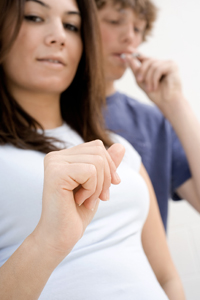
For example, studies have shown that marijuana impacts learning and concentration. Alcohol use by teens is shown to weaken their ability to retain information and also impairs judgment. Both substances often lead to an increase in risk-taking behavior. Additionally, some marijuana users will show signs of amotivational syndrome, which could significantly impact every area of their lives.
Further, the marijuana of today is not the marijuana of the ‘70s—more than twice the concentration of THC is found in today’s marijuana, according to the Office of National Drug Control Policy. Many do not realize the effects of marijuana can last up to 24 hours after smoking. The U.S. Department of Health and Human Services reports that marijuana is the most frequently used illegal drug in the United States. They further report that nearly 50 percent of 12th graders have tried the drug.
So is your child at risk? The answer is undoubtedly yes. Many parents wonder if their child could be using. Most hope that their child would make a good decision if offered alcohol or drugs. Don’t be in denial—it is not always somebody else’s child. Education and prevention are key.
Things to consider:
- Be proactive. Talk about serious issues and concerns before they become a reality.
- Keep the lines of communication open. If your child feels it is safe to talk to you, he or she will.
- Don’t be vague. Set rules and let them know where you stand with regard to drugs and alcohol. Outline what is acceptable and what is not. When they engage in a particular behavior, they are in essence “signing up” for the consequence; make sure they understand this. Promote accountability and responsibility.
- Be a “hands-on” parent. Be involved, know what they are doing and who they are with.
- Encourage hobbies. Help them find something they enjoy and are good at. Being involved in something will limit the opportunity for them to find trouble or for trouble to find them.
- Finally, practice what you preach. Be a good role model; your beliefs and behavior do influence your child’s behavior. Be cognizant of the messages you are sending.
It is important to know the possible signs and symptoms of drug or alcohol abuse. However, use good judgment when evaluating the potential problem. Many symptoms can be common occurrences when it comes to teens and their ever-changing feelings and behaviors. Some signs are clear while others are more subtle. Remember—if you stay involved, you will be more able to detect any concerning changes. The American Academy of Pediatricians suggests that some potential signs may include:
- increased secrecy about possession, whereabouts or activities
- negative changes in school work
- missing school or declining grades
- subtle changes in conversation with friends (e.g. more secretive, using “coded” language)
- new friends or peer group
- changing clothing choices/new fascination with clothes that highlight drug use
- increase in borrowing money or having extra cash
- possible physical changes (red eyes, runny nose)
- significant mood changes
- lack of interests in activities
- loss of interest in personal appearance
- isolation, depression or fatigue
- hostility or lack of cooperation
- distancing self from family friends or hobbies.
What to do if your child is using:
- Address it. Ignoring the problem will not make it go away.
- Get help. A professional can take an objective position and help to navigate the way. TPW
Charisa Richardson is a state and nationally certified alcohol and drug counselor and owner of Richardson Counseling Center, LLC, with more than thirteen years of experience working with both adults and adolescents. For a free consultation call (309) 633-1030, or email your questions to RCCLLC@sbcglobal.net.
